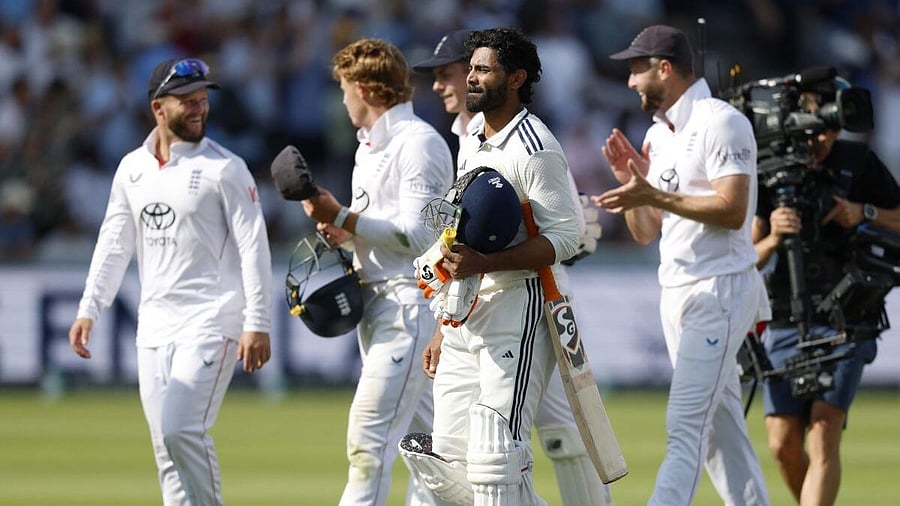
A dejected Ravindra Jadeja looks on as England players celebrate their victory.
Credit: Reuters Photo
India’s narrow 22-run defeat to England in the third Test at Lord’s will sting for a long time, not just because of the result, but because of how close they came. For the third time in a year, India found themselves chasing a modest fourth-innings target overseas and fell short due to self-inflicted factors. The match, which saw numerous momentum swings, was ultimately decided by one recurring flaw: India’s brittle batting under pressure, magnified across both innings.
Pant’s first-innings run-out: The start of the slide
India’s undoing arguably began on Day Three, with Rishabh Pant’s ill-timed dismissal in the first innings. Chasing England’s 387, India were cruising at 248 for 3. Pant was batting on 74, playing with maturity and flair. At the other end, KL Rahul was on 99.
In the final over before lunch, Pant attempted a single to help Rahul reach his century. A hesitation, a fumble, and a stroke of luck for English skipper Ben Stokes resulted in a direct hit later, and Pant was gone. What followed was a stunning collapse while India did manage to level the first innings score of England, 387.
“Pant's dismissal was more than just a run-out. It broke the spine of the innings. England went into lunch pumped up, and India never recovered,” said former India coach Ravi Shastri on Star Sports. “You cannot sacrifice a set batter before lunch on Day Three in a tight Test. That moment turned the match,” he added.
Indian Skipper Shubman Gill defended the decision, calling it “an error of judgement, not about personal glory.” But several former cricketers and analysts agreed that the dismissal shifted the momentum sharply in England’s favour.
Fourth innings: Poor shot selection, panic under pressure
India’s fourth-innings chase of 193 on a deteriorating Lord’s pitch demanded grit, discipline, and application — virtues that were sorely lacking.
Yashasvi Jaiswal, who has shown spark throughout the series, chased a wide outswinger early and was caught behind for 9. Shubman Gill, under pressure to lead from the front, once again fell fishing outside off, edging to second slip. Karun Nair, playing his first Test in years, looked nervous and misjudged the line of a Woakes delivery that nipped back in.
KL Rahul, India’s top scorer in first innings, continued to counter-attack and briefly gave hope with a 39 off 58. However, his dismissal allowed the English Team to believe that they could win the match from there.
“India seemed in a rush. The pitch wasn’t unplayable, but they made it look like a minefield,” said Mark Butcher on Sky Sports. “Gill, Nair, and Jaiswal all played away from the body. That’s not how you chase targets in England.”
By lunch on Day 5, India were tottering at 112 for 8. Ravindra Jadeja, batting with responsibility, tried to shepherd the chase, but fell short of partners at the other end. Jadeja remained the last recognised batter with the tail to follow. India's 8th wicket fell at the score of 112 in 40th over of the innings, needing another 81 to win the match. Jadeja managed to prolong the inning for another 35 overs with the support of a determined Bumrah and a gritty Siraj, and when India's last wicket fell in the 75th over, the score was 170, falling short by 22 runs.
This could have been a great Indian heist but was not meant to be, and series scoreline now stands at 2-1 in favour of England with two more matches to go.
Jadeja’s approach: Caught between shielding and striking
Ravindra Jadeja has built a reputation for calmly guiding India home with the tail. But on this occasion, his approach drew mixed reviews. Trying to farm the strike, Jadeja often turned down singles, waiting for boundaries. Eventually, he perished attempting to loft Atkinson over cover — caught by Ben Stokes with 33 still needed.
Sanjay Manjrekar said on Cricbuzz Live. “You can’t win the match single-handedly with three wickets in hand. The tail has to contribute.”
Aakash Chopra offered a sharper critique. “He got stuck in two minds. If you’re going to shield the tail, do it fully. Otherwise, rotate strike. This half-hearted approach only added pressure,” Chopra said on his YouTube channel.
A Pattern of Collapse
This is not an isolated incident. India have now lost four overseas Tests in the last two years where they were chasing less than 250 in the fourth innings. In Centurion, Cape Town, and now at Lord’s, the script has been eerily similar — early wickets, a middle-order fightback, and a lower-order implosion.
India’s team management has spoken often about “intent” and “positive cricket,” but when the situation demands composure and patience, the batters have repeatedly buckled.
Looking Ahead
The Lord’s Test was India’s to win — twice over. Once when Pant and Rahul were dominating the first innings, and again when the target of 193 looked manageable with eight wickets in hand. That they failed to cross the line both times reflects poorly not just on individuals, but on a team culture that hasn’t learned from recent collapses.
As the series stands 2-1 heading into the fourth Test, India must reflect deeply. For a side brimming with talent, the inability to finish games in pressure situations remains the Achilles' heel — and one that could define this Test series.
